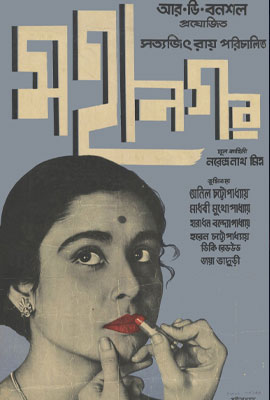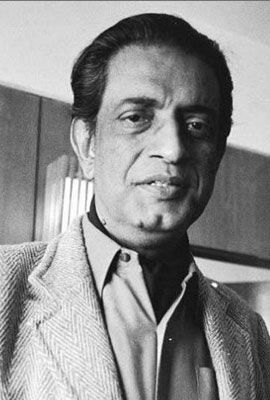
(1963)
directed by Satyagit Ray
This deeply heartfelt film by Satyagit Ray tells the story of a woman who forsakes her traditional role as housewife by taking a job outside the home. Once she enters the working world, she brings its perspectives back to her family life and her family life begins to change. Similarly, she brings her personal perspective with her into the working world. That a woman’s personal perspective can be a powerful force in the world is an essential principle of feminist thought and is front and center in Ray’s magnificent film.
“The Big City” begins by introducing us to a traditional Indian family in 1950’s Kolkata. Arati (Madhabi Mukherjee) is a young housewife. The household consists of her husband, Subrata (Anil Chatterjee), their two children, and his parents. The first part of the film focuses on the intimate details of their family life. Arati prepares tea for Subrata when he arrives home from work, administers medicine to her elderly father-in-law, prepares meals, spoils her young son, and helps her daughter with her homework. Unfortunately, they are having trouble making ends meet on Subrata’s small salary as a bank clerk. One evening, Subrata mentions that a friend’s wife has found a job and has begun working. From that moment, Arati decides she wants to get a job.
My favorite scene in “The Big City” occurs early in the movie when Arati whispers in her sleeping husband’s ear, “I am going to get a job.” The subject is so sensitive that she only has enough courage to bring it up while her husband is sleeping! When he awakens and asks what she has been whispering, she manages to retain just enough courage to repeat to her husband that she wants to get a job. This scene conveys their close, intimate relationship. It also conveys the sensitivity of the idea of a wife taking a job in India at that time. After a long, painful deliberation, they decide that Arati must find a job. The grandparents are mortified. They believe that no self-respecting man would allow his wife to work.
Arati’s confidence falters when she learns that job hunting involves letters of introduction and interviews. Subrata, however, finds an advertisement for a job, writes the application letter, and sends Arati off for an interview. Her charm and intelligence are immediately apparent to her interviewer and Arati gets a job demonstrating a knitting machine.
Her new job offers Arati an opportunity to interact with people from different levels of society. Slowly and hesitantly, Arati learns to use lipstick, wear dark glasses, and speak confidently. We see Arati develop a sense of the larger world. We are thrilled when she becomes the most successful saleswoman in the firm.
Edith, one of Arati’s colleagues at work, belongs to the Anglo-Indian community, which originated from relationships between British men and Indian women. Denied equality by the British and not accepted by Indians, they were generally regarded as immoral and dishonest. Arati transcends those racial stereotypes and becomes close to Edith. Arati has begun to establish another “family” at work. Arati supports and comforts members of her family. If a family member is threatened, she defends them fiercely.
When Arati’s boss, who has always been kind to Arati, questions Edith’s moral character and fires her, Arati resigns to protest what she sees as a great injustice. This leads to a crisis for Arati’s family because the bank where Subrata works has failed and Subrata has also lost his job. Financial disaster appears imminent. Subrata rises to the occasion, however. He is proud of his wife’s courage and willingness to take a moral stand. He comforts her and tells her they will certainly find new jobs in such a large city.
“The Big City” explores the psychological and social dimensions of work. Ray celebrates the beneficial effects of work on Arati’s life. The unfair dismissal of Edith, on the other hand, reveals the harsh, arbitrary side of capitalism. Ray focuses on his characters’ family relationships and their conscience in the face of injustice. Loyalty to one’s family is ultimately the most important value in this extraordinarily moving film.
Satyagit Ray

Satyagit Ray, the director of “Pather Panchali,” started his career as a commercial artist. He was drawn into film making after meeting the French director Jean Renoir and after seeing Vittorio De Siva’s Italian neorealist film “Bicycle Thieves” during a visit to London.
When Ray started filming his movie “Pather Panchali,” he had never directed a single scene, his cinematographer had never filmed a single scene, and his child actors had never acted. Despite all this inexperience, early footage was so compelling it helped Ray obtain financing for the rest of his movie.
Inexperience may have actually fostered creativity. At the time, movie crews waited for good weather and shut down production if it was raining. Ray followed his instincts and solved problems like how to film in the midst of a rain storm with umbrellas, tarps, and a “must do” attitude.
Ray was the first Indian to receive the Academy Honorary Award for his tremendous impact on film making. Ray was the second film personality after Charlie Chaplin to be awarded an honorary doctorate degree by Oxford University. Ray also received numerous other awards and honors including the Commander of the National Order of the Legion of Honour, the highest decoration in France.
Ray’s genius was matched by his humility. According to the leading actor Babita, “One of the most remarkable experiences working with Satyagit Ray was when one day, while shooting, I had to cross a small bridge on foot. I had to take my slippers off and forgot to pick them up. When I turned around, I was shocked to see that Mr. Ray was carrying my slippers! This was a lesson in humility that I’ll never forget.”
Ray was a hands on director. His script writing and directing were accompanied by his meticulous set and costume designs. He designed the calligraphy for the opening credits, selected the cinematography, composed the music (sometimes in collaboration with composers like Ravi Shankar), and designed the posters for his film releases.
Satyagit Ray was a director of breathtaking talent and breadth. Ray took the earth, the sky, the rivers, and the clouds, introduced his simple, heartwarming stories, and fashioned his characters from the ordinary people of his beautiful country.